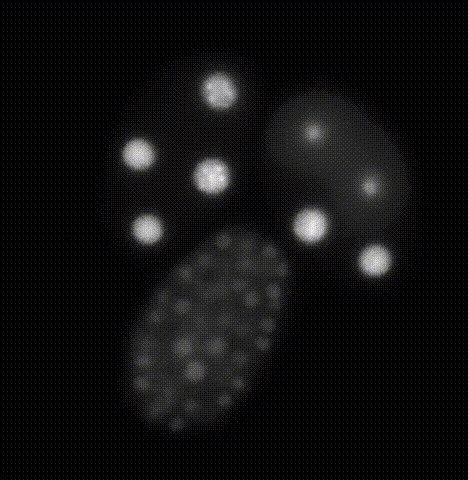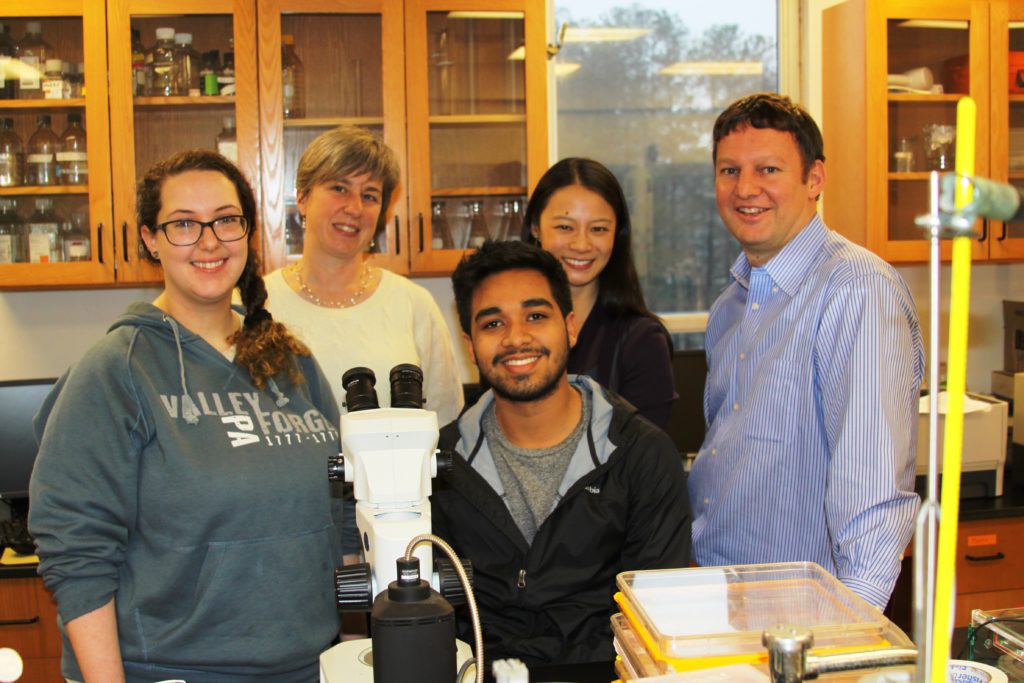How an innovative undergraduate research partnership is benefiting Oglethorpe, Emory and Alzheimer’s research.
When Oglethorpe’s Dr. Karen Schmeichel and Emory University’s Dr. David Katz came up with the idea for a research partnership between the two institutions, they envisioned an opportunity for Oglethorpe students to conduct hands-on research and gain experience in the lab. They never imagined those students would end up doing research that could one day help identify a drug to treat Alzheimer’s Disease.
But that’s exactly what happened.
The research revolves around a humble worm known as C. elegans. The worm is a “model organism,” a favorite in biology research labs. In fact, C. elegans was the first multicellular organism to have its entire genome sequenced. Because researchers already know a lot about the worm, studying it can help illuminate the pieces they’re less sure about—like a Rosetta stone for the ongoing mysteries of biology.
C. elegans is also an excellent organism for student research. The worms develop quickly and mate reliably, providing a wealth of genetic data for budding scientists. “You can go from an egg to an adult worm in four days and start all over again,” says Dr. Teresa Lee, a researcher in Dr. Katz’s lab. “So we can move faster through the genetic principles we’re trying to teach.” Plus, if a student’s worm colony accidentally meets its demise, the worm’s speedy life cycle means the student can build another colony in time to complete their assignment.

This video of C. elegans mitosis — the first captured by an Oglethorpe student, Caitlin Brightwell ’10 — shows a four-cell embryo dividing, with chromosomes splitting apart and creating by the end, an 8 to 16 cell stage embryo.
Over the past couple years, hands-on research with C. elegans has become a core aspect of the Oglethorpe biology experience. The program is funded in part by the National Science Foundation, which supports institutions like Oglethorpe that are expanding the boundaries of undergraduate science research. It’s a big change from the old curriculum, which was built on a foundational lecture course, loaded with memorization and vocabulary drills—the traditional approach at universities everywhere.
In contrast, Oglethorpe’s new curriculum emphasizes student engagement, using explorations in the lab to put theory to practice and help students build a repertoire of research skills.
“We totally reconfigured the introductory biology experience,” says Dr. Schmeichel, assistant professor of biology and the division chair. “All the lessons are driven by the questions we’re asking in the lab. This really allows students to ask a question drawn from their own authentic curiosity.”
The approach is one that could only work at a smaller institution like Oglethorpe, where each new class of students encounters the science curriculum in cohorts. And in the close-knit science department, faculty have the agility and flexibility to collaborate on the project of sequential knowledge-building.
A promising start—but the skill set that empowers undergrads to conduct original research isn’t built in a semester. So Dr. Schmeichel and her colleagues—Dr. Lea Alford, Dr. Charlie Baube and Dr. Roarke Donnelly—devised an even more innovative approach. The science professors created a succession of experiential learning courses, each building on the one before it. With every semester, students build confidence and gain additional skills.
The approach is one that could only work at a smaller institution like Oglethorpe, where each new class of students encounters the science curriculum in cohorts. And in the close-knit science department, faculty have the agility and flexibility to collaborate on the project of sequential knowledge-building. “My biology colleagues here at Oglethorpe have all embraced this project,” says Dr. Schmeichel. “They’ve gone outside their comfort zones in adopting worm modules in their courses, which all contribute to the skill development pipeline.”
First, students are introduced to C. elegans as a model organism. They learn how to care for the worm and how to do simple crosses based on Mendelian genetics. They master statistical techniques to better analyze these processes. They explore worm mutations. And they practice keeping a worm colony alive for future experiments.
In the second year, students conduct an eight-week genetic project with worms. They learn a protocol called RNA interference that allows them to disrupt or “knock down” the function of any of the worm’s genes. They refine their skills in managing worm colonies and achieve greater competence in performing genetic crosses for long-term research.
By the third year, the students have gained impressive experience with C. elegans, and the skills and confidence to conduct original research in collaboration with the Katz lab.
That’s where things really start to get interesting.

Caitlin May ’16 (the Katz lab’s summer 2015 intern), Dr. Karen Schmeichel, Elias Castro ’17 (the 2016 Katz lab intern), Dr. Teresa Lee, and Dr. David Katz
Dr. Katz’s research is in epigenetics, changes to gene function that don’t involve alterations to the actual DNA. For example, changes in how the DNA is packaged can affect gene function over an an organism’s lifetime. Sometimes these changes are passed between generations. His lab works with both C. elegans and mice to better understand the mechanisms that decide whether or not epigenetic information is transferred to an organism’s offspring.
Dr. Katz is particularly interested in an enzyme called LSD1 (Lysine Specific Demethylase 1), which plays a role in turning genes off before they’re passed on; the enzyme is found in organisms from worms to mice to humans. In worms, the enzyme is referred to as SPR-5.
When researchers knock out the spr-5 gene in worms, the following generations show significant and increasing defects in fertility. But knocking out LSD1 in mice—and by extension, humans—has even more severe consequences.
When the Katz Lab engineered mice to remove LSD1 function between generations at fertilization, the progeny began exhibiting strange behaviors: appearing anxious and fearful, obsessively digging holes, clawing at their cages. Next, Dr. Katz and his colleagues developed a technique for turning off LSD1 in adult mice. To their surprise, these mice began to exhibit potential signs of a neurodegenerative condition, such as going limp when handled.
As Dr. Katz and his colleagues pursued this connection in more detail, they discovered promising evidence that links Alzheimer’s Disease to dysfunctions in the LSD1 pathway.
It’s labor-intensive work… but it offers just the right level of engagement for an eager class of students… who were surprised to learn that they weren’t just completing an assignment, but actually contributing to real scientific research.
This brings us back to the Oglethorpe students. Dr. Katz asked the Oglethorpe undergrads to explore a related and very important question—is there a way to counteract that effect?
To learn more, Dr. Katz gave the class a list of enzymes to investigate in C. elegans. Using their skills with RNA interference to knock down the genes that produce those enzymes, the students methodically generated worms that lacked both SPR-5 and another enzyme on Dr. Katz’s list.
If they could produce a combination that didn’t exhibit the normal fertility defects associated with a lack of SPR-5, it would suggest that the enzyme they were testing might be a good potential drug target for treating Alzheimer’s Disease.
It’s labor-intensive work, requiring many hours of work, but it offers just the right level of engagement for an eager class of students…who were surprised to learn that they weren’t just completing an assignment, but actually contributing to real scientific research.
“When they did those first experiments, I really wanted to know the results,” says Dr. Katz. “Because we’ve never done those experiments before, and they’re really important to what we’re doing.”
To Dr. Katz’s delight, the Oglethorpe students have already identified some promising leads.
“We are very interested in the possibility that some of these could be drug targets,” Dr. Katz says. His lab is now undertaking drug screening to look for potential compounds that would target these pathways for Alzheimer’s Disease drugs.
While the Katz lab benefits from what Dr. Schmeichel terms a “twenty-headed undergraduate student”—otherwise known as a small army of hardworking researchers-in-training—Oglethorpe is benefiting from the arrangement, too. As a large research university, Emory has access to scientific resources beyond Oglethorpe’s capacity. For example, the exhaustive library of bacteria strains the students use for RNA interference projects; a collection like this costs around $15,000. Or the microscopes to perform differential interference microscopy and confocal microscopy; together the set costs around half a million dollars. Oglethorpe undergrads use these scopes to film and image their worms.
The postdocs in Dr. Katz’s lab are enthusiastic about the collaboration, too. Dr. Teresa Lee and Dr. Brandon Carpenter are conducting research under Dr. Katz’s mentorship; both aspire to serve as educators as well as researchers. They’ve taken the lead in coaching the Oglethorpe undergrads.“One of the beauties of the collaboration is that it goes both ways,” says Dr. Carpenter. “It’s not just research experience for undergrads who will get the experience they need to be competitive. For me and Teresa, we’re getting the skill necessary to be good PIs [principle investigators]. We’re all building and developing our resumes so we can hit the ground running when we start as faculty members.”
Dr. Lee agrees. “It’s been so invaluable to go into an actual classroom with actual students and see both the limitations and the unexpected surprises that happen. The goal of what we’re doing at Oglethorpe is to show them that biology—and research in general—is a living thing. We’re pushing them into the unknown.”
The results are particularly impressive for a project that’s still in its infancy. In fact, Dr. Schmeichel was chosen to speak at the prestigious American Society for Cell Biology 2016 Meeting in San Francisco, where she presented the collaboration as a model for other institutions. As the Oglethorpe biology department has transitioned into the new curriculum, each new cohort of students has gotten more experience with C. elegans. This year’s class is the first to benefit from the entire program.
Next on the horizon is a new science and innovation building at Oglethorpe. This planned addition to campus will offer mixed-use classrooms that double as lecture hall and laboratory, with flexible spaces for demonstrations, discussions and hands-on research. These future classrooms will bring together theory and practice, supporting biology’s new inquiry-based curriculum.
What discoveries will Oglethorpe students make next?
